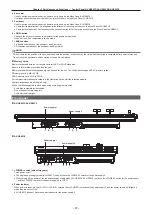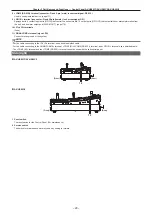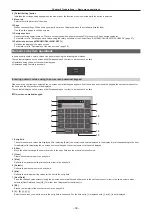
– 26 –
Chapter 3 Part Names and Functions — Control Panel AV‑HS60C1/AV‑HS60C2/AV‑HS60C4
r
Transition status display
Fig. 1
Fig. 2
Fig. 3
Fig. 4
The transition status display at the left side of the fader lever indicates not the lever position but the amount of transition, and also works during auto
transition.
During pattern limitation, the amount of limitation will also be displayed. (Fig. 1)
If the fader lever position and the amount of images do not match after memory playback or auto transition execution, every other display will be
displayed. When displayed at one side (Fig. 2, Fig. 3), push the lever towards the displayed side to make the lever position recognize.
If multiple operations of BKGD and KEY1 to KEY4 are performed in the next transition, both sides may become unmatched. In such a case, the display
will be like Fig. 4, so move the fader lever back and forth to make the lever position recognize.
KEY/DSK operation areas
CG5V
CG6V
CAM1
CAM2
CG1V
CG2V
CG3V
CG4V
1
2
3
4
5
1
2
3
4
5
KEY operation area
DSK operation area
1
Operation target selection buttons (<KEY1>/<KEY2>/<KEY3>/<KEY4>/<DSK1>/<DSK2>/<DSK3>/<DSK4>)
Selects the operation target for key/DSK preset memory.
Switches target to be displayed in the SEL KEYPVW output. (page 150)
2
Key/DSK preset memory buttons (<1>/<2>/<3>/<4>)
Recalls/stores the key preset memory. (page 102)
f
Short press: Recalls data saved to the corresponding button. (Recall)
f
Long press: Stores the current key settings to the corresponding button. (Store)
Current key setting can be deleted (Delete) by press and holding. For details, refer to “Key preset” (page 102).
3
<KEY1 ON>/<KEY2 ON>/<KEY3 ON>/<KEY4 ON>/<DSK1 ON>/<DSK2 ON>/<DSK3 ON>/<DSK4 ON> buttons
Executes/cancels each key with a cut transition.
4 Source name display panels
Displays the source name selected for each key.
5
<KEY1 TRNS>/<KEY2 TRNS>/<KEY3 TRNS>/<KEY4 TRNS>/<DSK1 TRNS>/<DSK2 TRNS>/<DSK3 TRNS>/<DSK4 TRNS> buttons
Executes transition with the transition type and transition time for each key set in the menu. (pages 63, 77)
Positioner area
2
1
3
4
5
6
7
1 Memory card access LED
Lights up while accessing the memory card.
Do not turn off the power of the unit or eject the memory card while lit. The memory card or data in the memory card may be damaged.
2 Memory card slot
Insert an SD memory card (optional) or an SDHC memory card (optional).
3
Positioner buttons (<X>/<Y>)
<X> button
Enables/disables the X-axis operation of the positioner (horizontal direction). When set to on, operation is enabled.
<Y> button
Enables/disables the Y-axis operation of the positioner (vertical direction).
Содержание AV-HS60C1E
Страница 5: ...Please read this chapter and check the accessories before use Chapter 1 Overview ...
Страница 32: ...This chapter describes basic operations and matters to be performed prior to use Chapter 4 Preparations ...
Страница 52: ...This chapter describes menu operations Chapter 5 Basic Operations ...
Страница 118: ...This chapter describes the input output signal settings Chapter 6 Input Output Signal Settings ...
Страница 129: ...This chapter describes how to operate the CONFIG menu displayed when the CONF button is pressed Chapter 7 CONFIG Menu ...
Страница 140: ...This chapter describes how to operate the system menu displayed when the SYS button is pressed Chapter 8 System Menu ...
Страница 162: ...This chapter describes the difference with the Standard mode Chapter 9 3G mode 4K mode ...
Страница 168: ...This chapter describes the terminals and signals of the unit Chapter 10 External Interfaces ...
Страница 173: ...This chapter describes the dimensions and specifications of this product Chapter 11 Specifications ...
Страница 184: ...This chapter describes the setting menu table and terms Chapter 12 Appendix ...
Страница 206: ...Web Site http www panasonic com Panasonic Corporation 2014 ...






























